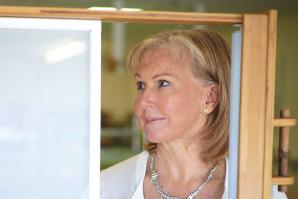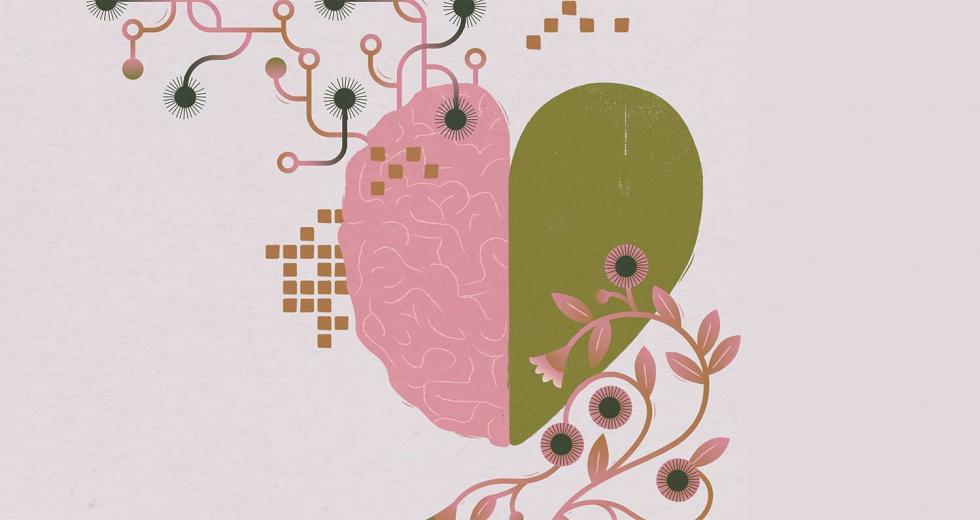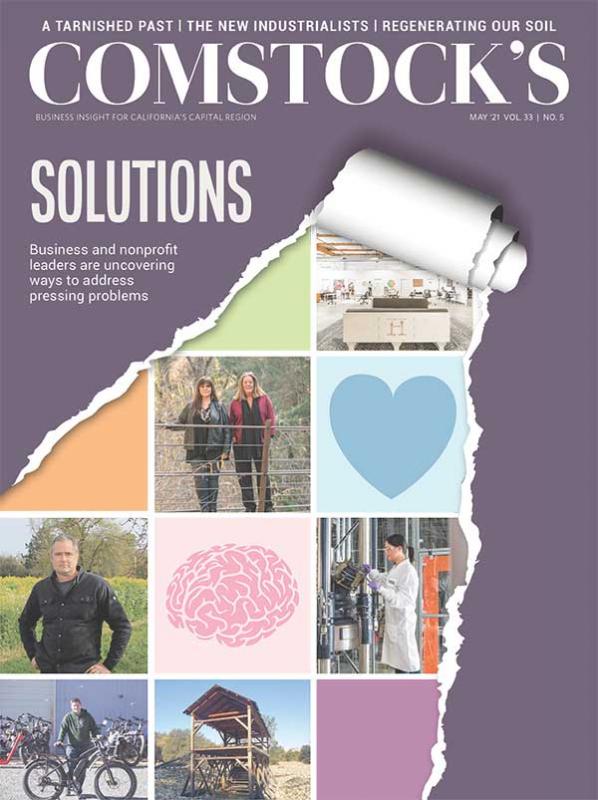When Elizabeth Dodson moved from Maryland to El Dorado Hills, she and her husband bought a new home. Three years later, the hot-water heater broke. The warranty had just expired (of course), costing Dodson more than $2,000. She made a typical rookie mistake: Because she wasn’t familiar with hard water, which is common in the Capital Region, she didn’t know that she needed to regularly flush the heater to remove mineral sediment buildup.
For Dodson, this was a setback, not a catastrophe. But she asked her contractor, “What happens to the people who make this mistake and can’t afford a new hot-water heater?” She was told they take cold showers and wash dishes with cold water, and the cold water doesn’t kill bacteria. Best case, they’re uncomfortable. Worst case, they get sick.
Dodson felt awful for homeowners in this position. And she kept thinking about it. Her empathy would lead to more questions, more brainstorming and eventually spawn the idea for HomeZada, an online resource that helps homeowners keep track of their home’s upkeep and finances.
Technology tends to be associated with things like computers, algorithms and machines, but the world of technology and innovation has long embraced a concern for other humans. “The concept of empathy is central to any type of entrepreneurship,” says Eric Ullrich, cofounder and chief operating officer of Hacker Lab, a makerspace and coworking facility in Sacramento. “It’s one of the driving values of innovative thinking.” Empathy is one of the first things Hacker Lab teaches entrepreneurs. And it’s not just a matter of altruism or having a heart: Empathy is innovation’s secret sauce.
Putting Customers’ Needs First
When aspiring CEOs work with StartupSac, a nonprofit aimed at helping startups, they’re often introduced to design thinking, a model for how to think about customers and products. “And that’s all about empathy and putting yourself in your target customer’s shoes,” says Laura Good, StartupSac’s cofounder. The basics of design thinking: Start not with a widget or a solution but with the end user. What are their actual problems? What do they really want? A crucial part of design thinking, says Good, is a process called customer discovery, which is a method of “designing your product through customer input” and ensuring a solution solves a problem people actually have, instead of wasting time developing something no one really wants.
Take the case of Trifecta Nutrition, a Sacramento-based organic-meal delivery company. On an obvious level, the company’s mission — providing healthy food — flows from empathy. “Losing weight is hard. Almost everyone on Earth can attest to that, so it’s easy for us to put ourselves in our customers’ shoes every day,” says Elizabeth Connolly, Trifecta’s cofounder and president. Yet, on a more strategic level, Connolly and her team work to better understand customers’ needs and then tweak products accordingly.
Connolly originally assumed, for example, that most of Trifecta’s customers wanted a specific diet plan, like ketogenic or vegan, but she was surprised to find that wasn’t the case. “After talking to many customers, we realized they were just following trends, and they actually just wanted a way to lose weight,” she says. So Trifecta quickly pivoted, creating online content about weight loss or muscle gain, as well as interactive quizzes to help customers find a meal plan that works for them. “You name any business decision, and I can probably tie it back to feedback we got from customers,” says Connolly.
This sense of empathy, of course, is a more expansive use of the word than simply being sensitive to how someone feels. Ullrich says it’s largely about looking at the world through an end user’s point of view. “It’s almost like the scientific process,” says Ullrich. “You have to talk to the customer, observe the customer, and look at data and look at the reports.”
That’s the approach Sedale Turbovsky took in 2018, when he set out to tackle a problem faced by researchers and nonprofits: the nightmare of grant applications. Applying for grants can be a slog — the public funding system is confusing and Byzantine. So he launched Sacramento-based OpenGrants, an online system that tries to bring ease and transparency to the world of grants. “Empathy is huge in developing a good product,” says Turbovsky, the company’s CEO and cofounder. “The ability to understand your customers’ needs and motivations is key as you craft everything from product features to marketing language.”
OpenGrants didn’t start with the product, it started with questions. Turbovsky’s team spent six months interviewing potential customers before building anything, which helped them better understand the “frequent culture clashes” between government agencies and the private sector, he says, and then designed the platform in a way that’s user-friendly for both camps.
‘Empathy Is Everywhere’
“Empathy is everywhere in the software world,” says Mac Clemmens, cofounder and CEO of Sacramento-based website development company Digital Deployment. (Clemmens is a member of Comstock’s Editorial Advisory Board, and Digital Deployment provides website support for Comstock’s.) The spirit of UX (user experience), after all, is to look at the interface through the literal eyes of the user. And an empathetic approach can pay surprising dividends. In 2018, when Digital Deployment redesigned its website’s user interface, it paid special attention to people with visual and intellectual disabilities.
This won Digital Deployment an Access Award from Disability Rights California. Then came a more lucrative reward. “Our search engine results went through the roof,” says Clemmens, as Google “spiders” that crawl through websites — reading and analyzing text on each page — noticed the higher quality of content (such as describing images with accompanying text that could be read aloud through a screen reader to the visually impaired) and boosted Digital Deployment’s search engine optimization.
Larger companies can benefit from a dose of empathy too. Take the example from Clayton Christensen, author of “The Innovator’s Dilemma,” who found that McDonald’s was startled by an odd trend: It was selling an unexpected amount of milkshakes in the morning. So it studied the reasons people were buying milkshakes for breakfast and learned customers wanted something to do on long commutes to work. They could slurp a shake without making a mess. McDonald’s then tweaked the formula to make its shakes even thicker, which would make it last longer on the drive. (The “empathy” isn’t about altruism for the shake slurpers but rather a way of looking at the world from the customers’ POV.)
In design and tech circles, a focus on empathy has been quietly growing since Daniel H. Pink’s 2005 book, “A Whole New Mind.” Pink argues that as traditional jobs are outsourced to other countries or to artificial intelligence, if leaders and employees want to keep their edge, they need to embrace more nonlinear and right-brain thinking. Empathy, Pink argued, is a skill leaders need to embrace to spur nonlinear ideation.
But even for skeptics of this kind of right-brain thinking, empathy can play a nuts-and-bolts role in the less glamorous bits of innovation. We tend to celebrate the light bulb moments, but creativity is only one part of the larger puzzle that is innovation, says Andrew Hargadon, a professor of technology management at UC Davis Graduate School of Management. Once an organization has the creative idea, there are still many challenges before the idea becomes a reality. Empathy helps that process. “If you’re the designer, you need empathy for what the engineers are going through,” says Hargadon, “or what the manufacturing engineers will have to go through.” Or the vice president of finance, or the general counsel, or the CEO, who will need to get a green light from the board of directors.
In this context, “empathy tends to transform your understanding of the problem,” says Hargadon, meaning that it might begin as a narrow problem of easing the customer’s pain points, but then — once the needs of others in the organization are more fully considered — it becomes a more “layered problem” by delighting the end user while, simultaneously, saving money on the widget and getting approval from the chief financial officer. A 360-degree approach to empathy helps clinch buy-in from all stakeholders.
Thinking about fellow engineers doesn’t need to be “touchy feely,” and empathy needn’t be warm and fuzzy, says Clemmens. He points out that Elon Musk, for example, isn’t known for having the most cuddly personality, but it was his concern for the planet — for carbon emissions (and, of course, profits) — that fueled the growth of Tesla.
Caring Helps Bottom Line
Caring about the world has financial implications too. Companies face a risk if they don’t care about broader social issues. Values matter. “People are not just buying the widget, they’re buying everything associated with it, (because) there’s much more collective consciousness from a consumer perspective,” says Cameron Law, executive director of Sacramento State’s Carlsen Center for Innovation & Entrepreneurship.
Law cites the example of Nike, which became linked with supporting former San Francisco 49ers quarterback Colin Kaepernick and his protest of injustice and police brutality. Some bought Nike products in support of the cause, and others boycotted it in opposition, but either way, Law says, “that goes back to empathy, and understanding why they’re doing what they’re doing.”
Regardless of where a CEO stands on social issues, the point is that it’s imperative a company has empathy for consumers’ values or it runs the risk of being tone-deaf.
If empathy is so crucial to innovation, then it logically follows that business owners should try to become more empathetic. How is this done? “It sounds pretty simple, but it really starts with a curiosity to learn someone else’s perspective,” says Law. “It doesn’t have to be right or wrong. But just really explore it, and recognize that that’s their truth.”
Dodson says that while her approach to empathy is largely subconscious, when she feels stressed, she “actively works on it,” and she makes it a point to ask more questions and make fewer assumptions. For example, when HomeZada’s customers ask questions by email, Dodson says they are usually short and sweet. So she responds by asking follow-up questions, getting them to elaborate and provide a better understanding of the roots of their problems.
To instill empathy in the company culture, Trifecta gives every new team member the book “Radical Candor” by Kim Scott that Connolly says “helps teach us how to be very honest with each other while simultaneously showing that we care deeply.” And Connolly lists the golden rule as one of his company’s core values: “We think that treating others how they deserve to be treated is the most empathetic way to approach our relationships.”
Finally, in some good news for beleaguered leaders: Your empathy homework might just be to relax. As part of the Hacker Lab community, through Zoom webinars like “Building Compassion,” Laura Chamberlin, an executive and life coach, instructs entrepreneurs on the importance of empathy. She says the best way to boost our capacity for empathy is to focus on repletion. If we’re chronically stressed, sleep-deprived or feasting on a diet of junk food, then our mindset comes from a place of scarcity.
Chamberlin recommends flipping the script. “Make changes so that instead we come from a place of abundance.” Essentially, this means taking better care of ourselves. Her recommendations include going for a walk and leaving the phone at home, or calling a good friend and talking about what’s on your mind, or treating yourself to a splurge meal. Her core message: Caring for others starts with caring for yourself.
And it might even spark a good idea.
–
Stay up to date on business in the Capital Region: Subscribe to the Comstock’s newsletter today.
Recommended For You

The New Industrialists
Meet four entrepreneurs in the Capital Region who are making a positive difference
Here are four entrepreneurs who are transforming ideas of manufacturing for the well-being of the world.

Greener Pastures
Long Dream Farm aims to prove that dairy production can be both ethical and economically viable
Andrew and Krista Abrahams want to rethink the assumptions of traditional dairy production.

Fostering the Future
Nonprofits, businesses and volunteers step up to help foster youth during the pandemic
May is National Foster Care Month, and the Capital Region has several nonprofits and businesses that work to improve the lives of foster youth.

Closing the Power Gap
Black Star Fund CEO and Chairman Kwame Anku on the importance of investing in Black entrepreneurs
Comstock’s spoke to Anku about his fund (which plans to close at $12 million in May) and the importance of investing in Black entrepreneurs.




